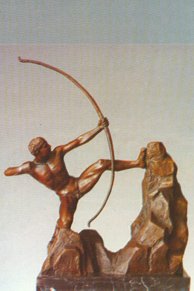Sarpastra, Sarpa-astra: 4 definitions
Introduction:
Sarpastra means something in Hinduism, Sanskrit. If you want to know the exact meaning, history, etymology or English translation of this term then check out the descriptions on this page. Add your comment or reference to a book if you want to contribute to this summary article.
In Hinduism
Dhanurveda (science of warfare)
Source: Wisdom Library: DhanurvedaSarpāstra (सर्पास्त्र) refers to a kind of weapon (a serpentine missile). It is a Sanskrit word defined in the Dhanurveda-saṃhitā, which contains a list of no less than 117 weapons. The Dhanurveda-saṃhitā is said to have been composed by the sage Vasiṣṭha, who in turn transmitted it trough a tradition of sages, which can eventually be traced to Śiva and Brahmā.

Dhanurveda (धनुर्वेद) refers to the “knowledge of warfare” and, as an upaveda, is associated with the Ṛgveda. It contains instructions on warfare, archery and ancient Indian martial arts, dating back to the 2nd-3rd millennium BCE.
Shaktism (Shakta philosophy)
Source: Google Books: ManthanabhairavatantramSarpāstra (सर्पास्त्र) or simply Sarpa refers to a “snake” and represents one of the attributes of Goddess Mālinī, according to the Śrīmatottara-tantra, an expansion of the Kubjikāmatatantra: the earliest popular and most authoritative Tantra of the Kubjikā cult.—Accordingly, while describing the Mūrti (visualized iconic form) of the goddess Mālinī: “She is like the rising sun and is blissful with wine. Very beautiful, she has five faces and is radiant with five time three eyes. She is adorned with beautiful earrings and shines with diadem and crown. She has ten arms adorned with many ornaments. O beloved, (she holds) a bow, javelin, conch, makes the gesture of fearlessness and holds a mirror. (Such) is the divine weapon in her left hands. (She holds) a thunderbolt, arrow, snake [i.e., sarpa], makes a boon bestowing gesture and holds a rosary. O goddess, such is the divine weapon (held) by (her) right (hands)”.

Shakta (शाक्त, śākta) or Shaktism (śāktism) represents a tradition of Hinduism where the Goddess (Devi) is revered and worshipped. Shakta literature includes a range of scriptures, including various Agamas and Tantras, although its roots may be traced back to the Vedas.
Purana and Itihasa (epic history)
Source: Shodhganga: Kasyapa Samhita—Text on Visha Chikitsa (itihasa)Sarpāstra (सर्पास्त्र) refers to “missiles or astras in the form of venomous snakes”, according to the Rāmāyaṇa, Yuddhakāṇḍa 102.24-6.—The Garuḍāstra is applied by Rāma in the fierce battle with Rāvaṇa, when the missiles or astras in the form of venomous snakes (sarpāstra) were directed at him, Rāma effectively rendered them powerless with the Garuḍāstra from which troops of Suparṇas who are the enemies of sarpas felled them. Nothing more is said about Garuḍamantra in Rāmāyaṇa.

The Purana (पुराण, purāṇas) refers to Sanskrit literature preserving ancient India’s vast cultural history, including historical legends, religious ceremonies, various arts and sciences. The eighteen mahapuranas total over 400,000 shlokas (metrical couplets) and date to at least several centuries BCE.
Languages of India and abroad
Kannada-English dictionary
Source: Alar: Kannada-English corpusSarpāstra (ಸರ್ಪಾಸ್ತ್ರ):—[noun] a kind of mystic arrow, which, when shot, would produce a number of venomous snakes on the target enemies.
Kannada is a Dravidian language (as opposed to the Indo-European language family) mainly spoken in the southwestern region of India.
See also (Relevant definitions)
Partial matches: Sarpa, Astra.
Query error!
Full-text: Sarpabana, Sarpashara, Astra, Garudastra.
Relevant text
Search found 2 books and stories containing Sarpastra, Sarpa-astra, Sarpāstra; (plurals include: Sarpastras, astras, Sarpāstras). You can also click to the full overview containing English textual excerpts. Below are direct links for the most relevant articles:
Surgery in ancient India (Study) (by P. P. Prathapan)
5. Surgery in the Ramayana < [Chapter 2 - The concept and practice of Surgery in ancient India]
Bhishma Charitra (by Kartik Pandya)